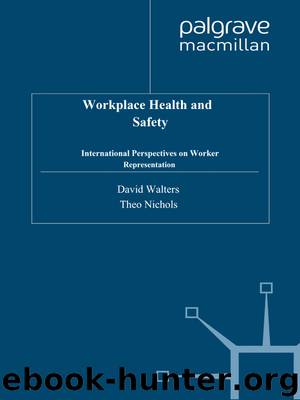Workplace Health and Safety by David Walters & Theo Nichols

Author:David Walters & Theo Nichols
Language: eng
Format: epub
Publisher: Palgrave Macmillan
Published: 2008-12-31T16:00:00+00:00
The project
To answer these questions, data collected through a fixed-response, self-administered questionnaire conducted between September and December of 2005 are used (Lewchuk et al., 2008). The questionnaire measures the physical conditions of work, the characteristics of the employment relationship and health outcomes for workers. The questionnaires were solicited from 60 Toronto area census tracts representing 145,109 households. Each household in the selected census tracts received a multilingual postcard inviting all members of the household over the age of 18 who had worked in the previous month to participate. Participants were offered Canadian $10.00 for completing the questionnaire, which they could mail, submit by e-mail, or complete online. Questionnaires were available in English, Chinese and Tamil. Posters with tear-off information sheets were posted in public spaces in the targeted areas to encourage more individuals to participate. Those who completed the questionnaire were asked to distribute additional postcards to people they thought might be interested in completing the questionnaire. Approximately 100 interviews with a random selection of survey participants in precarious employment relationships were conducted.
The analysis in this chapter uses the 1854 surveys received from households in the Greater Toronto Area representing non-full-time students who worked for pay in the previous month. It includes surveys from individuals who described themselves as employed under one of three employment relationship categories, including:
• Less permanent employment relationships (n = 316) defined as employed through a temporary employment agency or on a shortterm contract of less than one year. Employment could be either full time or part time, but in either case the relationship is temporary;
• self-employed without employees (n = 167); and
• permanent full-time (n = 1371).
The first two categories represent workers in precarious employment relationships. Those in less permanent relationships view themselves as employees, either full-time or part-time, but all working in a relationship that has a degree of non-permanency. Approximately one-third of this group worked less than 30 hours a week in the previous month. The self-employed did not self-identify as employees. However, it would be incorrect to see them as employers or ‘entrepreneurs’. They are a class of low-paid contractors, working on their own, many of whom are actually in disguised employment relationships. Nearly 40 per cent worked less than 30 hours a week in the previous month. Our interest in this chapter is to compare the experiences of full-time and part-time workers in precarious employment with the experiences of permanent full-time employees. Given this focus, the 148 permanent part-time workers in the sample are not part of the analysis.
This chapter’s focus is the association between employment relationship type and the effectiveness of the Internal Responsibility System. Three compounding factors were included in the analysis: sex, race and employment sector.2 Relative to Canada as a whole, the sample is representative of men and women over-represented in racialised visible minorities, and has similar employment sector characteristics to the economy as a whole. There was strong evidence that the employment relationship had an independent effect on many of the variables reported in this chapter, even after these three factors are controlled for.
Download
This site does not store any files on its server. We only index and link to content provided by other sites. Please contact the content providers to delete copyright contents if any and email us, we'll remove relevant links or contents immediately.
Tools of Titans by Timothy Ferriss(8157)
Change Your Questions, Change Your Life by Marilee Adams(7565)
Deep Work by Cal Newport(6818)
Man-made Catastrophes and Risk Information Concealment by Dmitry Chernov & Didier Sornette(5877)
Playing to Win_ How Strategy Really Works by A.G. Lafley & Roger L. Martin(5774)
Digital Minimalism by Cal Newport;(5588)
Big Magic: Creative Living Beyond Fear by Elizabeth Gilbert(5556)
The Slight Edge by Jeff Olson(5315)
Ego Is the Enemy by Ryan Holiday(5226)
The Motivation Myth by Jeff Haden(5125)
Stone's Rules by Roger Stone(4989)
The Laws of Human Nature by Robert Greene(4926)
Tuesdays with Morrie by Mitch Albom(4599)
Eat That Frog! by Brian Tracy(4381)
Rising Strong by Brene Brown(4341)
Skin in the Game by Nassim Nicholas Taleb(4123)
The Money Culture by Michael Lewis(4026)
Bullshit Jobs by David Graeber(3993)
Skin in the Game: Hidden Asymmetries in Daily Life by Nassim Nicholas Taleb(3868)
